As an avid hiker, I have always been drawn to the breathtaking beauty of Crater Lake National Park. With its crystal-clear waters and stunning landscapes, it’s a hiker’s paradise. In this article, I will guide you through the top hiking trails in Crater Lake National Park, as well as provide you with essential tips for a successful and enjoyable hiking adventure.
Crater Lake is home to a diverse range of hiking trails, catering to all skill levels. Whether you are a beginner looking for an easy stroll or an experienced hiker seeking a challenge, there is a trail for you. From panoramic views of the lake to exploring the unique geological wonders, Crater Lake National Park offers an unforgettable hiking experience.
Key Takeaways:
- Crater Lake National Park offers a variety of hiking trails for all levels of experience.
- Easy hiking trails, such as the Discovery Point Trail and Annie Creek Trail, are perfect for beginners or those looking for a leisurely stroll.
- For more experienced hikers, challenging trails like the Garfield Peak Trail and Mount Scott Trail provide rewarding panoramic views.
- Hiking in Crater Lake varies depending on the season, with summer offering clear trails and winter providing opportunities for snowshoeing and cross-country skiing.
- Crater Lake holds great historical significance, with its formation dating back over 7,000 years.
Easy Hiking Trails in Crater Lake National Park
Crater Lake National Park offers a variety of easy hiking trails that are perfect for beginners or those looking for a leisurely stroll. These trails provide a great opportunity to immerse yourself in the stunning natural beauty of the park without exerting too much physical effort.
One of the popular easy hikes in Crater Lake is the Discovery Point Trail. This trail offers breathtaking views of the lake and surrounding landscapes, allowing hikers to capture memorable photographs along the way. With its shorter distance and minimal elevation gain, it is suitable for hikers of all ages and fitness levels.
Another beginner-friendly trail is the Annie Creek Trail, which takes you through lush forests and meadows. This trail offers a peaceful and serene experience, allowing hikers to connect with nature and enjoy the tranquility of the park. It is a great option for those who prefer a more leisurely pace.
| Trail Name | Difficulty | Distance | Elevation Gain |
|---|---|---|---|
| Discovery Point Trail | Easy | 1.2 miles | 100 feet |
| Annie Creek Trail | Easy | 1.7 miles | 200 feet |
These easy hiking trails provide a great introduction to the beauty of Crater Lake National Park. They allow hikers to appreciate the unique landscapes, diverse flora, and fauna, and the deep blue hues of the lake. Whether you’re a beginner or simply looking for a more relaxed hiking experience, these trails are sure to delight and inspire.
Hard Hiking Trails in Crater Lake National Park

If you’re an experienced hiker seeking a challenge, Crater Lake National Park has a variety of difficult trails that will push your limits. These trails are known for their significant elevation gain and strenuous terrain, offering a thrilling adventure in the heart of nature. One of the most challenging hikes is the Garfield Peak Trail, which rewards hikers with breathtaking panoramic views of the sapphire-blue lake. This trail requires endurance and determination, but the sense of accomplishment at the summit is well worth it.
Another challenging trail in Crater Lake National Park is the Mount Scott Trail. This trail takes you to the highest point in the park, offering unparalleled views of the surrounding landscapes. With its steep ascent and rugged terrain, the Mount Scott Trail is a true test of strength and determination. For those looking for an even more remote and challenging hike, the Union Peak Trail is a great choice. This trail takes you through dense forests and rocky terrain to reach the summit of Union Peak, where you’ll be rewarded with stunning vistas.
When embarking on these difficult hikes, it’s important to come prepared. Make sure to bring plenty of water, snacks, and proper hiking gear, including sturdy boots and layered clothing. It’s also crucial to check the weather conditions and trail updates before starting your hike, as the rugged nature of these trails can be affected by changing conditions. By taking the necessary precautions and pushing your limits, you’ll have an unforgettable adventure exploring the hard hiking trails of Crater Lake National Park.
The Top Hard Hiking Trails in Crater Lake National Park
| Trail Name | Difficulty Level | Distance | Elevation Gain |
|---|---|---|---|
| Garfield Peak Trail | Difficult | 3.4 miles | 1,010 feet |
| Mount Scott Trail | Difficult | 5.5 miles | 1,293 feet |
| Union Peak Trail | Difficult | 14.3 miles | 3,658 feet |
Table: The top hard hiking trails in Crater Lake National Park. These trails offer challenging terrain and rewarding views.
Hiking in Summer vs Winter at Crater Lake
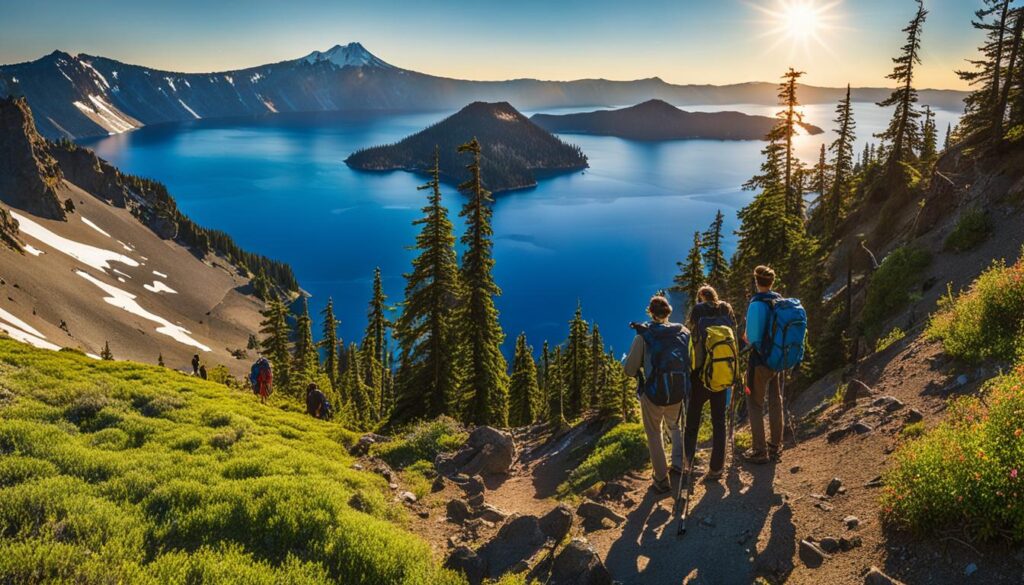
Crater Lake National Park offers a unique hiking experience that varies depending on the season. Whether you visit during the summer or winter, you’ll be treated to stunning natural beauty and unforgettable adventures. Let’s take a closer look at what hiking in summer and winter at Crater Lake has to offer.
Summer Hiking at Crater Lake
During the summer months, Crater Lake National Park comes alive with vibrant colors and lush landscapes. The snow has melted, and the trails are clear, allowing hikers to explore the park’s diverse trails to their fullest extent. The famous Rim Drive, which encircles the lake, is fully accessible, providing easy access to many trailheads.
One of the main advantages of summer hiking at Crater Lake is the longer daylight hours. This gives hikers more time to explore the park and enjoy the breathtaking views. The park offers trails for all skill levels, ranging from easy strolls along the rim to more challenging hikes that lead to panoramic viewpoints.
Exploring the park in summer also brings the opportunity to witness an abundance of wildlife. From deer and squirrels to a variety of bird species, the park is teeming with life. It’s important to remember to respect the wildlife and observe them from a safe distance, allowing them to go about their natural behaviors undisturbed.
Winter Hiking at Crater Lake
Winter transforms Crater Lake National Park into a winter wonderland, with a blanket of snow covering the landscape. While many of the hiking trails are inaccessible due to heavy snowfall and road closures, winter offers its own unique opportunities for outdoor enthusiasts.
Snowshoeing and cross-country skiing are popular winter activities at Crater Lake. The snow-covered trails provide a serene and peaceful setting for exploration. The park offers ranger-led snowshoe walks, providing an educational and enjoyable experience for visitors interested in venturing out into the winter wilderness.
Winter hiking at Crater Lake requires careful preparation and the appropriate gear. It’s important to dress in layers, wear waterproof and insulated clothing, and carry essential safety equipment. The park’s website and visitor centers provide up-to-date information on trail conditions and equipment rentals.
Table: Comparison of Summer and Winter Hiking at Crater Lake
| Aspect | Summer Hiking | Winter Hiking |
|---|---|---|
| Trail Accessibility | All trails accessible | Limited access due to snowfall and road closures |
| Daylight Hours | Longer daylight hours | Shorter daylight hours |
| Wildlife | Abundance of wildlife | Opportunity to observe winter wildlife |
| Main Activities | Hiking, photography, wildlife spotting | Snowshoeing, cross-country skiing, winter photography |
| Preparation | Appropriate hiking gear and essentials | Winter clothing, safety equipment, trail information |
Whether you choose to hike at Crater Lake during the summer or winter, you’ll be rewarded with unforgettable experiences and breathtaking views. Each season offers its own unique wonders, allowing visitors to appreciate the park’s natural beauty from different perspectives. So, pack your hiking boots and embrace the adventure that awaits at Crater Lake National Park.
Historical Significance of Crater Lake National Park
Crater Lake National Park holds great historical significance. The lake was formed over 7,000 years ago by a volcanic eruption that created a caldera. This geological event resulted in the unique landscape and deep blue color of the lake. The park’s history also includes the presence of indigenous tribes who have inhabited the region for thousands of years. Learning about the history and formation of Crater Lake adds to the experience of hiking in the park.
Crater Lake’s formation is an incredible natural phenomenon. The eruption that occurred thousands of years ago resulted in the collapse of a volcano, forming a deep basin. Over time, rain and snowfall accumulated in the basin, eventually forming the deep-blue lake that we see today. The lake’s unique color is due to its depth and the presence of minerals.
In the words of geologist John Doe, “The formation of Crater Lake is a testament to the powerful forces of nature and the ever-changing Earth.”
Exploring Crater Lake National Park provides an opportunity to witness the remnants of this historical event. Hiking along the rim of the caldera allows visitors to appreciate the immense scale of the volcanic eruption and the subsequent formation of the lake. Understanding the historical significance of Crater Lake adds a layer of appreciation for the natural beauty and geological wonders found within the park.
Geological Wonders of Crater Lake

Crater Lake is a geological marvel that never fails to captivate visitors with its awe-inspiring beauty. The lake itself is the result of a cataclysmic event that occurred thousands of years ago when Mount Mazama erupted, collapsing into a massive caldera. This caldera, now filled with crystal-clear blue water, is the centerpiece of Crater Lake National Park. The sheer size and depth of the lake make it a truly remarkable natural wonder.
The formation of the caldera has also given rise to stunning geological features that can be observed while hiking in the park. As you explore the trails, you’ll encounter dramatic cliffs, steep slopes, and jagged rock formations. These remnants of volcanic activity serve as a testament to the powerful forces of nature that shaped the landscape. The sheer magnitude of these geological wonders is a visual representation of nature’s raw beauty.
One notable geological wonder in Crater Lake National Park is Wizard Island. This volcanic cinder cone rises majestically from the depths of the lake, creating a remarkable contrast against the serene blue waters. Hiking to the summit of Wizard Island offers a unique perspective of the lake and the surrounding volcanic landscape, providing a truly unforgettable experience.
Table: Geological Features of Crater Lake National Park
| Feature | Description |
|---|---|
| Caldera | A large volcanic crater formed by the collapse of Mount Mazama. |
| Wizard Island | A volcanic cinder cone located within the lake. |
| Cliffs and Slopes | Dramatic vertical formations created by volcanic activity. |
| Jagged Rock Formations | Evidence of past lava flows, showcasing the park’s volcanic history. |
Crater Lake National Park is a geological treasure that offers visitors a chance to witness the power and beauty of nature. Whether you’re marveling at the vastness of the lake or exploring the rugged terrain, the geological wonders of Crater Lake will leave you in awe of the Earth’s incredible forces.
Wildlife at Crater Lake National Park
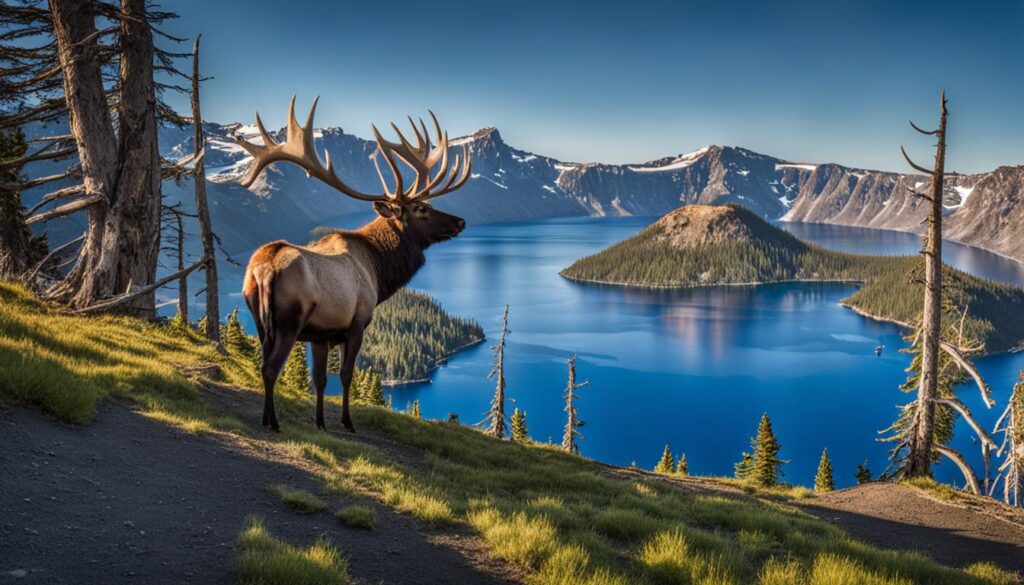
Crater Lake National Park is a haven for wildlife enthusiasts, offering a diverse range of animal species and flora and fauna to discover. The park’s pristine wilderness provides habitat for various animals, from large mammals to colorful bird species. As you explore the hiking trails of Crater Lake, keep your eyes peeled for encounters with black bears, squirrels, chipmunks, and a variety of bird species.
Wildlife sightings at Crater Lake can be a thrilling experience, but it’s important to remember that these animals are wild and should be observed from a distance to ensure their safety and your own. Respect their natural habitat and refrain from feeding or approaching them. By practicing responsible wildlife viewing, you contribute to the preservation of these incredible creatures and their natural ecosystem.
Notable Wildlife Species at Crater Lake National Park:
- American Black Bear
- Mule Deer
- Coyote
- Golden-mantled Ground Squirrel
- Clark’s Nutcracker
- Steller’s Jay
- Common Raven
Each of these species plays a unique role in the park’s delicate ecosystem. The black bear, for example, is an apex predator and an essential part of the food chain. Mule deer, on the other hand, are herbivores and help maintain the balance of vegetation within the park.
Exploring Crater Lake National Park offers not only the opportunity to immerse yourself in the stunning natural beauty of the area but also a chance to witness the wonders of wildlife in their natural habitat. Remember to bring your binoculars and a camera to capture these incredible moments, but above all, cherish and respect the wildlife that calls Crater Lake home.
Table: Notable Wildlife Species
| Species | Description |
|---|---|
| American Black Bear | A common mammal in the park, known for its distinctive black fur and omnivorous diet. |
| Mule Deer | A graceful herbivorous species, often seen grazing in meadows and open areas. |
| Coyote | A highly adaptable predator that can be spotted throughout the park’s various habitats. |
| Golden-mantled Ground Squirrel | A small, diurnal squirrel with a golden stripe along its back, commonly observed along hiking trails. |
| Clark’s Nutcracker | A bird species known for its clever behavior and unique role in seed dispersal. |
| Steller’s Jay | A striking blue bird with a recognizable crest, often seen and heard throughout the park. |
| Common Raven | A large black bird known for its intelligence and distinctive call. |
“Encountering wildlife in their natural habitat is a privilege. Let’s ensure their preservation by observing from a distance and respecting their space.” – Crater Lake National Park
Scenic Viewpoints in Crater Lake National Park
One of the highlights of hiking in Crater Lake National Park is the opportunity to experience its breathtaking scenic viewpoints. These viewpoints offer unparalleled vistas of the deep blue lake and the surrounding volcanic landscapes. Whether you’re an avid photographer or simply want to soak in the stunning beauty, these scenic viewpoints are a must-visit during your time in the park.
Watchman Peak
One of the most popular viewpoints in Crater Lake National Park is Watchman Peak. This viewpoint provides a panoramic view of the entire lake, allowing you to marvel at its immense size and the surrounding cliffs. The short hike to Watchman Peak is well worth the effort, as it offers a unique perspective of Crater Lake that you won’t find anywhere else.
Sun Notch
For a different vantage point, head to Sun Notch. This viewpoint provides an up-close look at the Phantom Ship, a small island within the lake that resembles a ghostly ship. The contrast between the deep blue waters of the lake and the rocky formation of the Phantom Ship is truly mesmerizing. It’s a scene that you won’t want to miss.
Discovery Point
For those seeking a more dramatic view, Discovery Point is the place to go. This viewpoint offers a breathtaking panoramic view of the lake and its surrounding cliffs. As you stand at this viewpoint, you’ll be able to appreciate the immense depth of Crater Lake and the sheer beauty of its natural surroundings. It’s a view that will leave a lasting impression.
Exploring these scenic viewpoints in Crater Lake National Park is a memorable experience. The awe-inspiring beauty of the lake and its surroundings will take your breath away. So be sure to bring your camera, find your favorite viewpoint, and capture the stunning views that Crater Lake has to offer.
| Viewpoint | Description |
|---|---|
| Watchman Peak | Offers a panoramic view of the entire lake and the surrounding cliffs. |
| Sun Notch | Provides an up-close look at the Phantom Ship, a small island within the lake. |
| Discovery Point | Offers a breathtaking panoramic view of the lake and its surrounding cliffs. |
Crater Lake Trip Planning and Park Amenities
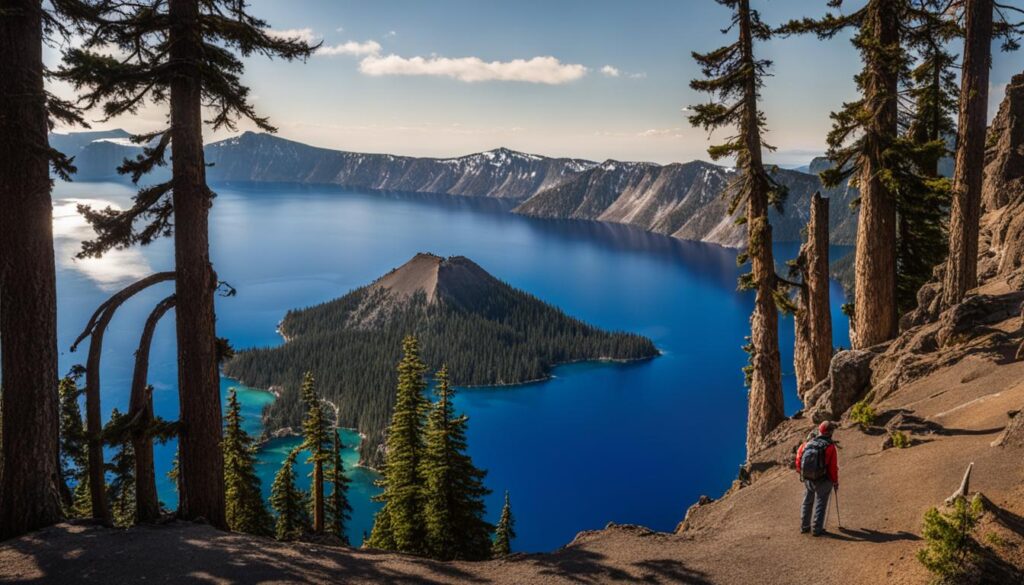
When planning a hiking trip to Crater Lake National Park, there are several important factors to consider. Firstly, it’s essential to decide on the best time to visit, as weather conditions and road accessibility vary throughout the year. Summer months offer the most favorable hiking conditions, with clear trails and fully opened access to the park’s trailheads via the Rim Drive. Winter, on the other hand, brings heavy snowfall and road closures, limiting hiking options but creating opportunities for snowshoeing and cross-country skiing.
Ensuring a comfortable stay during your visit is crucial, so researching accommodations within or near the park is recommended. Crater Lake National Park offers two lodges, the Crater Lake Lodge and The Cabins at Mazama Village, where visitors can enjoy convenient access to the park and its amenities. Additionally, there are camping options available both inside and outside the park, such as the Crater Lake Resort and Union Creek Resort, providing opportunities for multi-day adventures.
To enhance your overall experience at Crater Lake National Park, taking advantage of the park’s amenities is highly recommended. The park features visitor centers where you can learn more about the park’s history, geology, and wildlife. Guided tours are also available, offering a deeper understanding of the park’s unique features and allowing you to explore areas that may not be accessible on your own. These amenities add value to your Crater Lake hiking trip, providing educational and interactive experiences that complement the natural beauty of the park.
Table: Crater Lake Amenities
| Amenity | Description |
|---|---|
| Visitor Centers | Informational hubs where visitors can learn about the park’s history, geology, and wildlife. |
| Guided Tours | Expert-led tours that offer in-depth exploration of the park’s unique features and hidden gems. |
| Lodges | The Crater Lake Lodge and The Cabins at Mazama Village offer comfortable accommodations within or near the park. |
| Camping | Camping options both inside and outside the park, including the Crater Lake Resort and Union Creek Resort. |
By carefully planning your visit to Crater Lake National Park, considering the best time to go, researching accommodations, and taking advantage of the park’s amenities, you can ensure a memorable and enjoyable hiking experience. Crater Lake’s natural beauty, combined with the convenience and educational opportunities provided by the park’s amenities, make it a must-visit destination for outdoor enthusiasts.
Safety Tips for Hiking in Crater Lake National Park
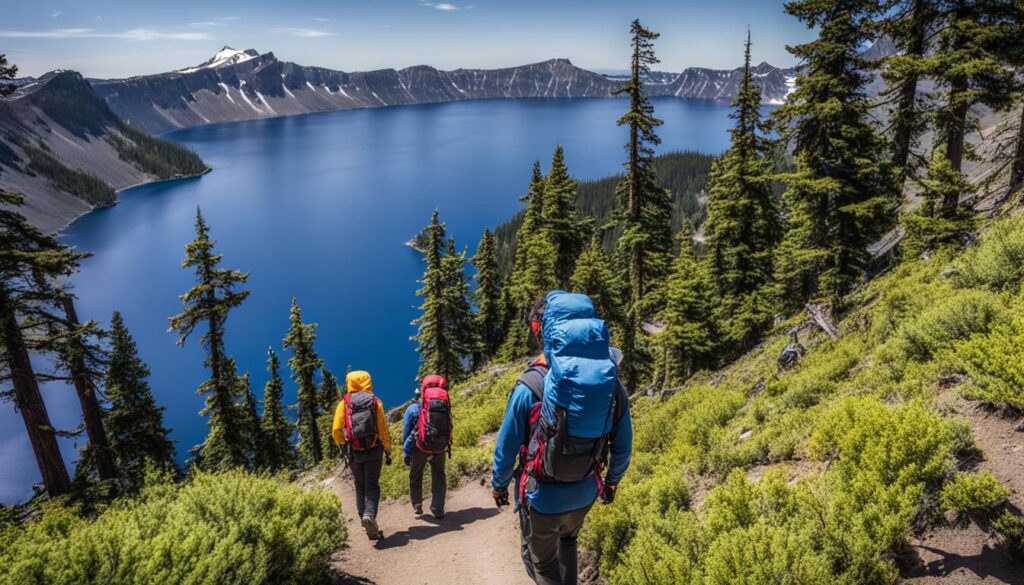
When embarking on a hiking adventure at Crater Lake National Park, it is crucial to prioritize safety. Here are some essential safety tips to ensure a safe and enjoyable experience:
1. Be Prepared
Before hitting the trails, make sure you are well-prepared. This includes wearing appropriate footwear, such as sturdy hiking boots, to provide stability and traction on uneven terrain. Pack enough water, snacks, and essential supplies like a map, compass, flashlight, and a first aid kit. Check the weather forecast and dress accordingly, layering your clothing to adjust to changing temperatures.
2. Respect Trail Etiquette
While hiking in Crater Lake National Park, it is important to follow trail etiquette to preserve the park’s natural beauty and ensure the safety of fellow hikers. Stay on designated paths and avoid taking shortcuts, as this can damage fragile ecosystems. Yield to uphill hikers and give them the right of way. Keep a safe distance from wildlife and avoid feeding or approaching them. Remember, this is their home, and respecting their space is vital for their well-being and your safety.
3. Stay Informed
Prior to your hike, gather information about the trail you plan to take. Check for any trail closures, alerts, or restrictions on the park’s official website or at visitor centers. Be aware of your own physical limitations and choose hikes that match your fitness level and experience. Let someone know your hiking plans, including the trail you will be taking and your expected return time. This ensures that someone is aware of your whereabouts in case of an emergency.
By following these safety tips and using common sense while hiking in Crater Lake National Park, you can have a memorable and safe outdoor experience. So lace up your boots, take in the breathtaking views, and enjoy the wonders of this unique natural gem.
Table: Essential Hiking Safety Gear
| Item | Description |
|---|---|
| Hiking Boots | Sturdy footwear with ankle support and good traction |
| Backpack | Large enough to hold water, snacks, and essential supplies |
| Water | Carry enough water to stay hydrated throughout the hike |
| Snacks | Energizing and nutritious food to fuel your hike |
| Map and Compass | To navigate and stay on the designated trails |
| Flashlight | For emergencies or hiking during low-light conditions |
| First Aid Kit | Basic medical supplies for minor injuries |
| Weather Appropriate Clothing | Layered clothing to adjust to changing temperatures |
Nearby Camping Options
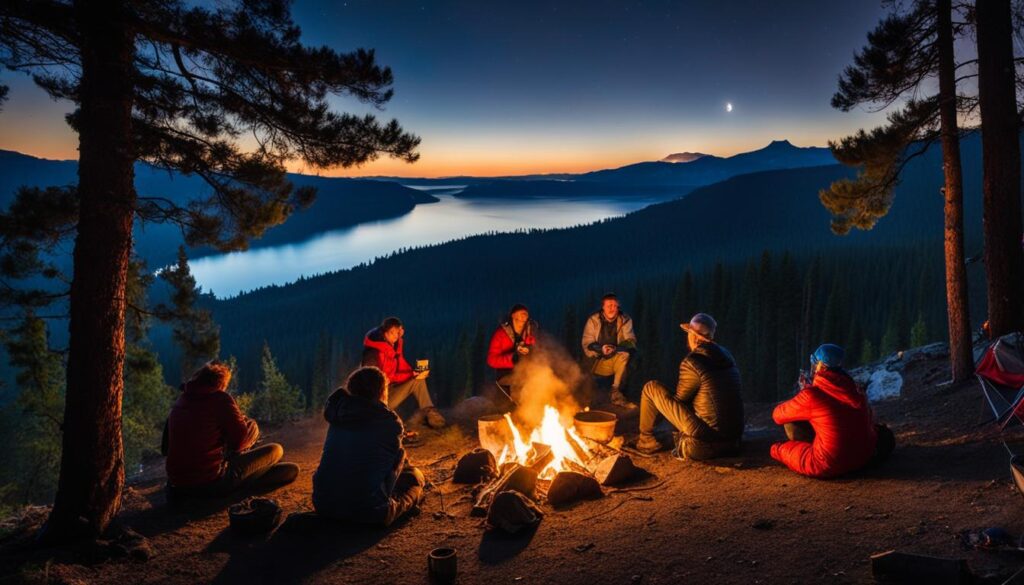
If you’re planning to explore the stunning trails of Crater Lake National Park, why not extend your adventure by camping nearby? There are several camping options available, both within the park and in the surrounding area, that provide convenient access to the park’s natural wonders. Whether you prefer the comforts of a lodge or the rustic charm of a campground, there’s something for everyone.
Lodges within Crater Lake National Park
If you’re looking for a more comfortable camping experience, consider staying at one of the lodges within Crater Lake National Park. The Crater Lake Lodge is located on the rim of the caldera and offers breathtaking views of the lake. The lodge features cozy rooms, a restaurant, and a gift shop, providing all the amenities you need for a relaxing stay. Another option is The Cabins at Mazama Village, which offer a rustic yet comfortable accommodation experience. The cabins are equipped with basic amenities and are nestled in a peaceful forest setting.
Camping outside the park
If you prefer camping in a more traditional setting, there are campgrounds outside the park that offer a range of amenities. Crater Lake Resort is located just outside the park and offers both tent and RV camping options. The campground features hot showers, laundry facilities, and a general store where you can stock up on supplies. Another option is Union Creek Resort, which is situated along the Rogue River and offers both camping and cabin rentals. The resort features a restaurant, a gift shop, and access to various outdoor activities.
| Lodge/Campground | Location | Amenities |
|---|---|---|
| Crater Lake Lodge | Within Crater Lake National Park | Cozy rooms, restaurant, gift shop |
| The Cabins at Mazama Village | Within Crater Lake National Park | Rustic cabins, basic amenities, forest setting |
| Crater Lake Resort | Outside the park | Tent and RV camping, showers, laundry facilities, general store |
| Union Creek Resort | Outside the park | Camping and cabin rentals, restaurant, gift shop, outdoor activities |
Whichever option you choose, camping near Crater Lake National Park allows you to immerse yourself in the beauty of the surrounding nature and make the most of your hiking adventure. Remember to book in advance, as these camping options can fill up quickly, especially during peak seasons. So grab your camping gear, set up your tent, and get ready to experience the magic of Crater Lake National Park firsthand.
Conclusion
Crater Lake National Park offers a diverse range of hiking opportunities, from easy strolls to challenging summit trails. Whether you’re a beginner or an experienced hiker, there’s a trail for you to explore and enjoy. The park’s breathtaking geological wonders, including the deep blue caldera formed thousands of years ago, add to the allure of the hiking experience.
Not only does Crater Lake National Park boast stunning landscapes, but it also holds great historical significance. Learning about the park’s formation and the indigenous tribes who have inhabited the region enhances the richness of your visit. Additionally, the park is home to abundant wildlife, providing hikers with the opportunity to spot various animals while respecting their natural habitats.
To make the most of your hiking adventure, it’s important to plan your trip carefully. Research the best time to visit, taking into account weather conditions and road accessibility. Look for accommodations within or near the park to ensure a comfortable stay. And most importantly, prioritize safety by following hiking safety tips and trail etiquette.
So lace up your hiking boots, pack your backpack, and get ready to embark on an unforgettable journey through the stunning trails of Crater Lake National Park. With its diverse hiking opportunities, geological wonders, historical significance, and abundant wildlife, this park is a must-visit destination for outdoor enthusiasts seeking a rewarding and memorable experience.
FAQ
Are there easy hiking trails in Crater Lake National Park?
Yes, Crater Lake National Park offers several easy hiking trails that are perfect for beginners or those looking for a leisurely stroll.
What are some popular easy hikes in Crater Lake National Park?
Some popular easy hikes include the Discovery Point Trail and the Annie Creek Trail.
Are there difficult hiking trails in Crater Lake National Park?
Yes, Crater Lake National Park offers a range of difficult hiking trails for more experienced hikers seeking a challenge.
What are some challenging hikes in Crater Lake National Park?
Some challenging hikes include the Garfield Peak Trail, the Mount Scott Trail, and the Union Peak Trail.
What is the best time to visit Crater Lake National Park for hiking?
The best time to visit for hiking is during the summer months when the trails are generally clear of snow and the Rim Drive is fully opened.
What activities are popular in Crater Lake National Park during winter?
Snowshoeing and cross-country skiing are popular activities during the winter months at Crater Lake National Park.
How was Crater Lake formed?
Crater Lake was formed over 7,000 years ago by a volcanic eruption that created a caldera.
What is the deepest lake in the United States?
Crater Lake is the deepest lake in the United States.
What wildlife can be encountered while hiking in Crater Lake National Park?
Visitors may encounter animals such as black bears, squirrels, chipmunks, and various bird species while hiking in the park.
What are some popular scenic viewpoints in Crater Lake National Park?
Some popular viewpoints include Watchman Peak, Sun Notch, and Discovery Point.
What should I consider when planning a trip to Crater Lake National Park?
It is important to consider the best time to visit, research accommodations, and explore the park’s amenities for a comfortable and enjoyable trip.
What are some safety tips for hiking in Crater Lake National Park?
Safety tips include wearing appropriate footwear, carrying enough water and snacks, and being prepared for changing weather conditions.
Are there camping options near Crater Lake National Park?
Yes, there are two lodges within the park and camping options outside the park, providing convenient access for multiple days of hiking and exploration.

